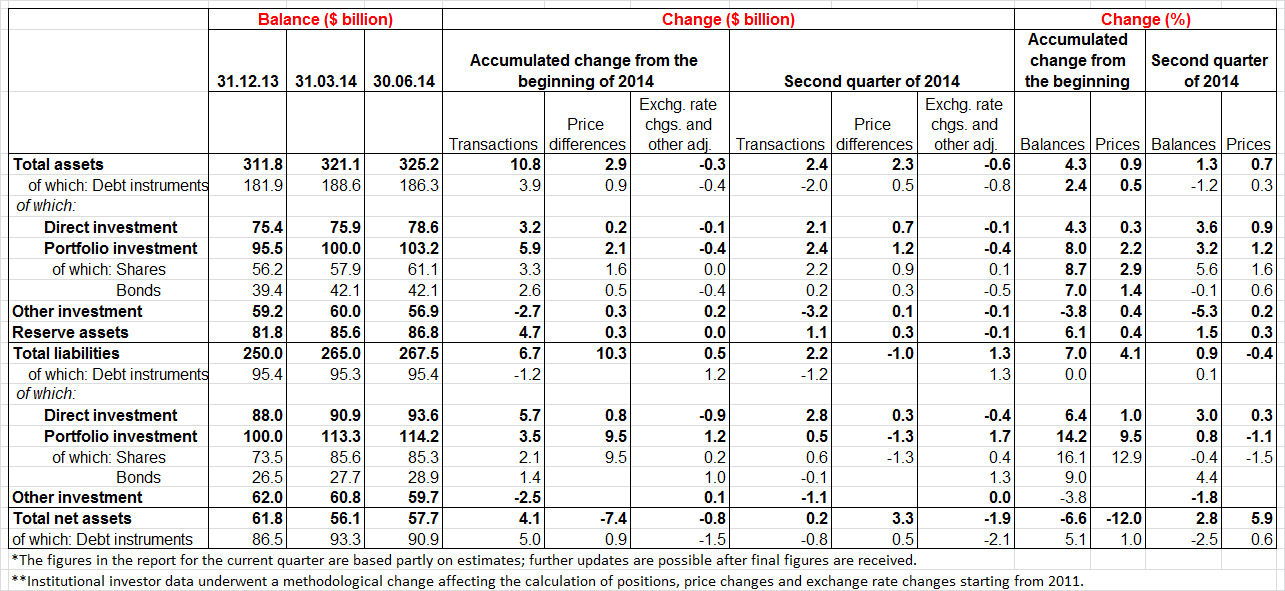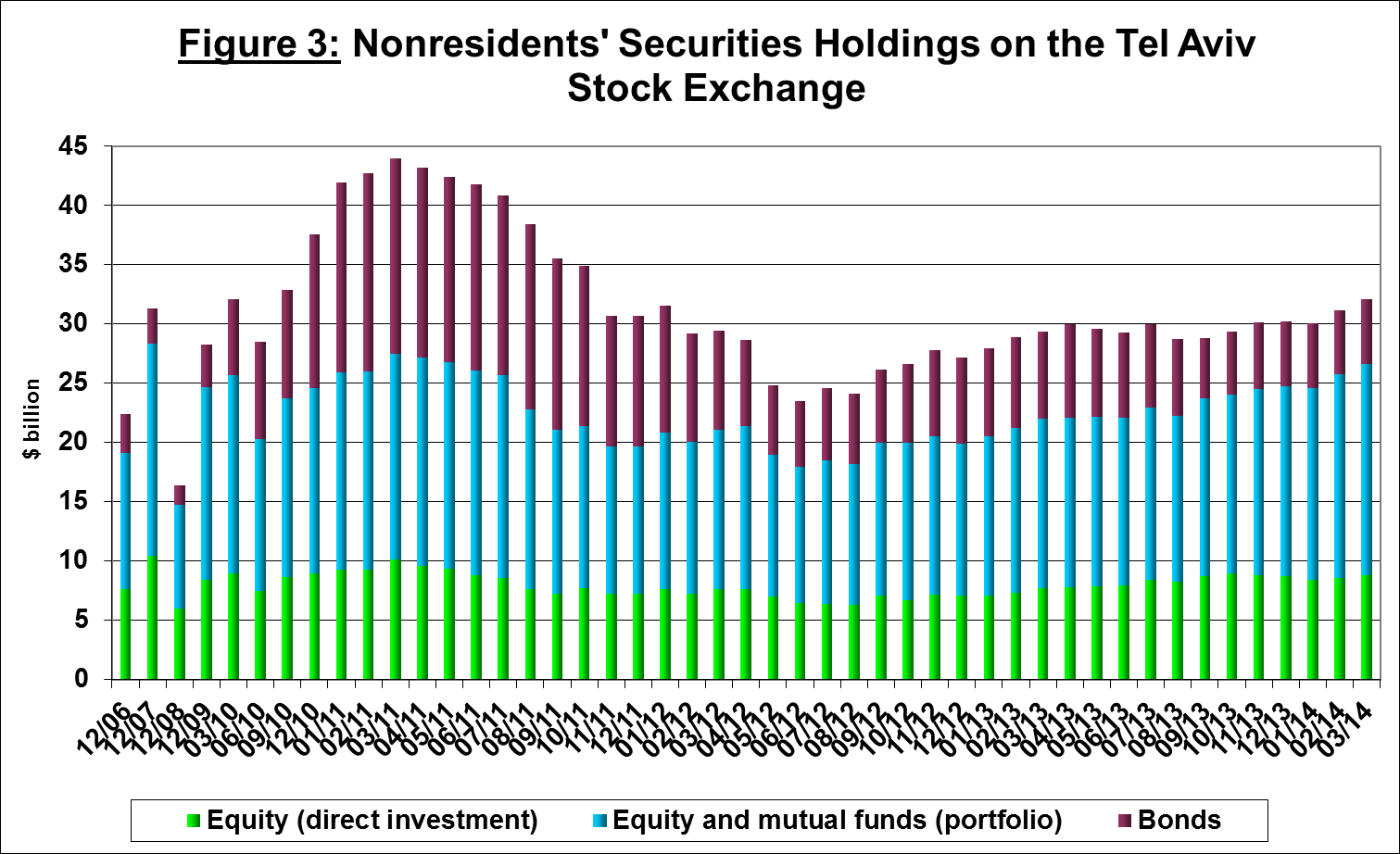- In the second quarter of 2014, Israel’s surplus of assets over liabilities vis-à-vis abroad increased by about 2.8 percent (about $1.6 billion), to about $57.7 billion at the end of June. An increase of about $4.1 billion (1.3 percent) in the value of assets held abroad by Israelis was partly offset by an increase of about $2.5 billion (0.9 percent) in the value of Israelis’ liabilities abroad.
- The increase in the value of the assets portfolio derived mainly from an increase in the flow of investments and in the value shares held by Israelis abroad (direct and financial) ($5.9 billion) and from an increase in the balance of reserve assets.
- The increase in the balance of gross liabilities abroad derived mainly from the flow of direct investments totaling about $2.8 billion.
- The gross external debt to GDP ratio continued to decline in the second quarter as well, by another 0.5 percentage points, to only about 30.8 percent at the end of June.
- The surplus of assets over liabilities vis-à-vis abroad in debt instruments alone (negative net external debt) declined in the quarter by about $2.4 billion (2.5 percent), and reached about $91 billion at the end of June.

Israel's net assets abroad (the surplus of assets over liabilities) increased during the second quarter of 2014 by about $1.6 billion (2.8 percent), to around $57.7 billion at the end of June. An increase of about $4.1 billion (1.3 percent) in the value of Israelis’ assets abroad was partly offset by an increase of about $2.5 billion (0.9 percent) in the value of Israelis’ liabilities to abroad (Figure 1).

The balance of Israelis’ assets abroad increased by about $4.1 billion (1.3 percent), to about $325 billion, at the end of June—comprised mostly of an increase in the value of investments by Israelis in shares traded abroad (direct and financial) ($5.9 billion) and in the balance of reserve assets. This increase was partially offset by sales of other investments abroad.
The value of the shares portfolio increased in the second quarter, by about $3.2 billion (5.6 percent): there was net flow of investments by Israelis of $2.2 billion, divided among the various sectors, and about $0.9 billion was in respect of price increases on stock markets abroad.
The balance of investments in tradable bonds abroad remained virtually unchanged in the second quarter. The flow of net investments in foreign bonds by institutional investors and households, totaling about $1.6 billion, was mostly offset by net sales by the banking system and the business sector.
The value of other investments declined by about $3.2 billion (5.3 percent) in the second quarter. Of this, there was a decline of about $2 billion in customer credit (as a result of a decline in exports). In addition, there were withdrawals of about $1.4 billion by Israelis from banks abroad, and of about $420 million by Israeli banks from their deposits in foreign banks. This decline was partially offset by growth in loans to abroad and in other assets.
The value of foreign exchange reserves increased by about $1.2 billion in the second quarter, mainly due to the Bank of Israel’s intervention in foreign exchange trading.
In the composition of residents' securities portfolio abroad, there was a continued increase in the second quarter of 2014 in the share of investment in foreign tradable securities, mainly at the expense of a continued decline in the weight of deposits and credit. These trends were accelerated since the financial crisis in 2008–09, a combination of a sharp decline in the share of deposits of Israeli residents in banks abroad and an increase in the flow of investment in foreign shares and in their market value (Figure 2).

The balance of Israel's liabilities to abroad increased during the second quarter of 2014 by about $2.5 billion (0.9 percent), derived from a $2.6 billion flow of direct investment into the economy and of about $570 million in Israeli financial shares traded in Israel and abroad. This increase was partly offset by a decline in share prices in Israel and by the withdrawal from deposits in Israel by nonresidents (about $1 billion).
The value of nonresidents' financial portfolio on the Tel Aviv Stock Exchange increased in the second quarter by around $0.9 billion (2.8 percent), to about $33 billion at the end of the quarter. Nonresidents invested about $1.1 billion in the tradable portfolio in Israel (stocks and bonds), which was partly offset by declines in prices (Figure 3).

The gross external debt
Israel's gross external debt increased slightly, by $0.1 billion (0.1 percent) during the second quarter of 2014, mainly as a result of an increase in the value of outstanding shekel-denominated bonds on the Tel Aviv Stock Exchange, and an increase in deposits in Israel by foreign banks. This increase was mostly offset by withdrawals by nonresidents from deposits in Israeli banks, and a decline in loans and suppliers’ credit.
The ratio of gross external debt to GDP declined in the second quarter, by about 0.5 percentage points, following on a decline of about 12.8 percentage points from the beginning of 2012 through the first quarter of 2014, to only 30.8 percent at the end of June (Figure 4).

The net external debt
The surplus of assets over liabilities abroad in debt instruments alone (negative net external debt) declined by about $2.4 billion (2.5 percent) in the second quarter, and reached $91 billion at the end of June (Figure 5).
The balance of short-term debt assets was about $133 billion at the end of June, mostly reserves at the Bank of Israel, reflecting a coverage ratio of 3.3 of short-term debt, a slight increase from the end of 2013.
